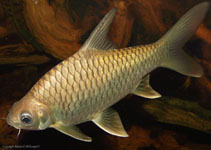Hochladen Photos und videos
Pictures | Google BildHypsibarbus vernayi
Picture by McKenzie, M.
Pictures | Google BildHypsibarbus vernayi
Picture by McKenzie, M.
Klassifizierung / Names Namen | Synonyme | Catalog of Fishes(Gattung, Arten) | ITIS | CoL | WoRMS | Cloffa
> Cypriniformes (Carps) > Cyprinidae (Minnows or carps) > Cyprininae
Etymology: Hypsibarbus: Greek, hypsi = high + Latin, barbus = barbel (Ref. 45335).
Eponymy: Arthur Stannard Vernay (1877–1960) was an English-born art & antiques dealer, big game hunter, naturalist and philanthropist who lived in the USA. [...] (Ref. 128868), visit book page.
More on author: Norman.
Etymology: Hypsibarbus: Greek, hypsi = high + Latin, barbus = barbel (Ref. 45335).
Eponymy: Arthur Stannard Vernay (1877–1960) was an English-born art & antiques dealer, big game hunter, naturalist and philanthropist who lived in the USA. [...] (Ref. 128868), visit book page.
More on author: Norman.
Environment: milieu / climate zone / depth range / distribution range Ökologie
; süßwasser benthopelagisch. Tropical
Verbreitung Länder | FAO Gebiete | Ecosystems | Vorkommen | Point map | Einführungen | Faunafri
Asia: Mekong, Chao Phraya and Meklong basins.
Size / Gewicht / Alter
Maturity: Lm ? range ? - ? cm
Max length : 30.0 cm SL Männchen/unbestimmt; (Ref. 116957); max. veröff. Gewicht: 250.00 g (Ref. 26563)
Max length : 30.0 cm SL Männchen/unbestimmt; (Ref. 116957); max. veröff. Gewicht: 250.00 g (Ref. 26563)
Kurzbeschreibung Bestimmungsschlüssel | Morphologie | Morphometrie
Rückenflossenweichstrahlen (insgesamt) : 8; Afterflossenweichstrahlen: 5. Distinguishable by its 14 circumpeduncular scales; 5+1/2 scale rows between lateral line and dorsal fin origin; 1 scale row between anus and anal fin origin; 9-11 predorsal scales; and the distances between distal serrae on posterior margin of last simple dorsal fin ray being similar to the width of the bases of the serrae (Ref. 27732). Lower half of the body a yellow tint; pectoral and anal fins yellow (Ref. 37768).
Life cycle and mating behavior Geschlechtsreife | Fortpflanzung | Ablaichen | Eier | Fecundity | Larven
Hauptreferenz
Upload your references | Referenzen | Koordinator | Partner
Kottelat, M., 1998. Fishes of the Nam Theun and Xe Bangfai basins, Laos, with diagnoses of twenty-two new species (Teleostei: Cyprinidae, Balitoridae, Cobitidae, Coiidae and Odontobutidae). Ichthyol. Explor. Freshwat. 9(1):1-128. (Ref. 27732)
IUCN Rote Liste Status (Ref. 130435: Version 2024-2)
nicht bedroht (LC) ; Date assessed: 28 March 2011
CITES
Not Evaluated
Bedrohung für Menschen
Harmless
Nutzung durch Menschen
FAO - Publication: search | FishSource |
Mehr Information
Trophic ecology
Nahrungsorganismen
Nahrungszusammensetzung
Nahrungsaufnahme
Food rations
Räuber
Nahrungsorganismen
Nahrungszusammensetzung
Nahrungsaufnahme
Food rations
Räuber
Ecology
Ökologie
Ökologie
Population dynamics
Growth parameters
Max. ages / sizes
Length-weight rel.
Length-length rel.
Längenhäufigkeiten
Mass conversion
Rekrutierung
Dichte
Growth parameters
Max. ages / sizes
Length-weight rel.
Length-length rel.
Längenhäufigkeiten
Mass conversion
Rekrutierung
Dichte
Life cycle
Fortpflanzung
Geschlechtsreife
Maturity/Gills rel.
Fecundity
Ablaichen
Spawning aggregations
Eier
Eientwicklung
Larven
Larven Pop.Dyn.
Fortpflanzung
Geschlechtsreife
Maturity/Gills rel.
Fecundity
Ablaichen
Spawning aggregations
Eier
Eientwicklung
Larven
Larven Pop.Dyn.
Anatomy
Kiemenoberfläche
Brain
Otolith
Kiemenoberfläche
Brain
Otolith
Physiology
Body composition
Nutrients
Oxygen consumption
Swimming type
Swimming speed
Visual pigments
Fish sound
Diseases & Parasites
Toxicity (LC50s)
Body composition
Nutrients
Oxygen consumption
Swimming type
Swimming speed
Visual pigments
Fish sound
Diseases & Parasites
Toxicity (LC50s)
Genetics
Genetik
Heterozygosity
Vererbbarkeit
Genetik
Heterozygosity
Vererbbarkeit
Human related
Aquaculture systems
Aquakultur Profile
Zuchtlinien
Ciguatera cases
Stamps, coins, misc.
Aquaculture systems
Aquakultur Profile
Zuchtlinien
Ciguatera cases
Stamps, coins, misc.
Tools
E-book | Feldführer | Bestimmungsschlüssel | Längenhäufigkeits Tool | Lebensdaten Tool | Punkt Karte | Classification Tree
| Catch-MSY |
Zusatzinformationen
Download XML
Zusammenfassung | Point data | Namen | Photos
Internet Quellen
AFORO (otoliths) | Aquatic Commons | BHL | Cloffa | BOLDSystems | Websites from users | FishWatcher Einträge suchen | CISTI | Catalog of Fishes: Gattung, Arten | DiscoverLife | ECOTOX | FAO - Publication: search | Faunafri | Fishipedia | Fishtrace | GenBank: Genom, nucleotide | GloBI | Google Books | Google Scholar | Google | IGFA World Record | MitoFish | Otolith Atlas of Taiwan Fishes | PubMed | Reef Life Survey | Socotra Atlas | Tree of Life | Wikipedia: Gehe zu, Suchen | World Records Freshwater Fishing | Zoological Record
Estimates based on models
Phylogenetic diversity index (Ref. 82804): PD50 = 0.5005 [Uniqueness, from 0.5 = low to 2.0 = high].
Bayesian length-weight: a=0.01413 (0.00786 - 0.02540), b=3.09 (2.94 - 3.24), in cm total length, based on LWR estimates for this species & (Sub)family-body (Ref. 93245).
Trophic level (Ref. 69278): 3.0 ±0.3 se; based on size and trophs of closest relatives
Widerstandsfähigkeit (Ref. 120179): mittel, Verdopplung der Population dauert 1,4 - 4,4 Jahre. (Preliminary K or Fecundity.).
Fishing Vulnerability (Ref. 59153): Low to moderate vulnerability (27 of 100).




